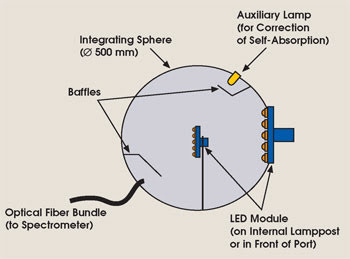Peter G. Läpple, Instrument Systems GmbH
The semiconductor light produced by LEDs has long been deployed in many areas of daily life, including as backlighting for displays and panel graphics on mobile phones, and for instrument clusters in cars. High-power LEDs entering the market are expanding applications to traditional illumination.
But high-power LEDs also present new challenges. Test-and-measurement systems for individual LEDs have been technically refined with highly developed, fast spectroradiometers, but for lighting applications, systems from conventional photometry such as goniophotometers and large integrating spheres must be deployed. These systems generally use photometer measurement heads that are not accurate enough for LED spectra. One solution is to combine spectroradiometer technology with the systems of classical photometry.

The coating in integrating spheres ensures that the launched radiant flux incident on an area in the sphere's interior is reflected in such a way that the radiance or luminance is equal in all directions.
Today’s spectroradiometers can record key LED optical parameters such as luminous intensity and flux and chromaticity. However, high- power LEDs with luminous flux values above 100 lm need thermal management; some require heat dissipation. Temperature will influence their optical properties.
The light output, for example, can degrade by some 10 percent if the temperature goes up 40 K, and the color temperature of white LEDs changes to the point where it is clearly visible to the human eye. So one must carefully consider the thermal behavior of LEDs during optical analysis. Instrument Systems GmbH of Munich, Germany, has developed test adapters for this LED class that permit temperature measurement at the LED housing.
Despite the impressive light power, one LED is far from adequate for use as car headlights or interior illumination, which rely on clusters and modules. This is why the analysis of photometric parameters for modules is gaining importance. One can use a goniophotometer to analyze the spatial radiation pattern of an LED module.
In addition, a spectroradiometer used as a detector will allow determination of the distribution curve for luminous intensity and color, important for white LEDs because there can be major changes in color coordinates for different viewing angles.
Flux measurement
Even with LED clusters, end users employ integrating spheres to determine the luminous flux. This technology is basically a hollow sphere whose interior is coated with a material that is an almost-perfect diffuse reflector, ensuring that the total flux of light is integrated. Measurement quality largely depends on the homogeneity of the reflection properties within the sphere; thus, it is important to keep sources of errors such as openings and adapters in the sphere to a minimum. The self-absorption of the test specimen is a key factor during analysis of LED modules and should be taken into account when measurements are made.
Whether the application involves individual high-power LEDs or clusters, there is a trend toward using larger integrating spheres to minimize the defect area as a proportion of the interior area of the sphere. Sphere diameters of 75 to 150 mm were adequate for conventional single LEDs, but diameters of 250 to 500 mm are now recommended.
Meet the author
Peter G. Läpple is a sales engineer at Instrument Systems GmbH in Munich, Germany; e-mail: [email protected].